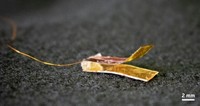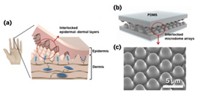Advertisement
Grab your lab coat. Let's get started
Welcome!
Welcome!
Create an account below to get 6 C&EN articles per month, receive newsletters and more - all free.
It seems this is your first time logging in online. Please enter the following information to continue.
As an ACS member you automatically get access to this site. All we need is few more details to create your reading experience.
Not you? Sign in with a different account.
Not you? Sign in with a different account.
ERROR 1
ERROR 1
ERROR 2
ERROR 2
ERROR 2
ERROR 2
ERROR 2
Password and Confirm password must match.
If you have an ACS member number, please enter it here so we can link this account to your membership. (optional)
ERROR 2
ACS values your privacy. By submitting your information, you are gaining access to C&EN and subscribing to our weekly newsletter. We use the information you provide to make your reading experience better, and we will never sell your data to third party members.
Materials
Artificial Skin Transmits Signals To Neurons
Materials Science: Interfacing pressure sensors and organic circuits with nerve cells could give prosthetics a sense of touch
by Celia Henry Arnaud
October 15, 2015
| A version of this story appeared in
Volume 93, Issue 41

Prosthetic limbs can restore an amputee’s ability to walk or grip objects, but they haven’t yet been able to restore a person’s sense of touch. Researchers at Stanford University have taken a step closer to this type of prosthetic by creating an electronic skin that responds to pressure changes and transmits signals via nerve cells, much as human skin does.
Zhenan Bao and coworkers made the artificial skin by connecting three components: microstructured resistive pressure sensors, flexible printed organic electronic circuits, and nerve cells containing light-activated ion channels (Science 2015, DOI: 10.1126/science.aaa9306).
The pressure sensors are made of a carbon nanotube-elastomer composite shaped into tiny pyramidal structures that are coated onto a surface. The sensor changes conductance in response to applied pressure. Bao previously made similar capacitive sensors, but the new resistive sensors better detect the range of pressures sensed by human skin.
Each sensor is connected to an organic circuit printed with the help of researchers at Xerox’s Palo Alto Research Center (PARC). The circuit converts the pressure signal into a series of electrical pulses and increases pulse frequency in response to increasing pressure. “This circuit is relatively simple to build,” Bao says. “It serves as the perfect electrical readout for our sensors.”
The researchers used the electrical pulses to modulate the frequency of a light-emitting diode. In their proof-of-concept study, they sent light from the LED through an optical fiber to stimulate neurons in mouse brain slices. The nerve cells in these samples were decorated with engineered channelrhodopsins that open in response to light, triggering nerve cells to fire.
The work represents “an important advance in the development of skinlike materials that mimic the functionality of human skin at an unprecedented level,” says Ali Javey, who is developing electronic skin at the University of California, Berkeley. “It could have important implications for the development of smarter prosthetics.”
“This is just the beginning of the path toward building fully integrated artificial skin,” Bao says. Next, she says, her team hopes to mimic other sensing functions of human skin, such as the ability to feel heat, and integrate them into the new platform.





Join the conversation
Contact the reporter
Submit a Letter to the Editor for publication
Engage with us on Twitter